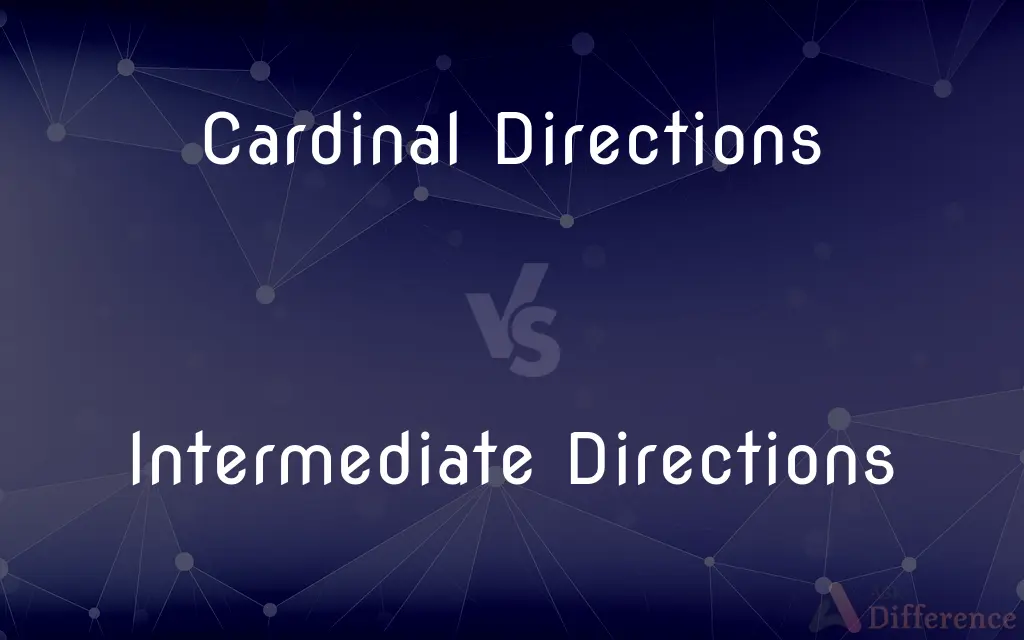Cardinal Directions vs. Intermediate Directions — What's the Difference?
Edited by Tayyaba Rehman — By Fiza Rafique — Published on November 7, 2023
Cardinal Directions are the main directions (North, South, East, West), while Intermediate Directions lie between them (Northeast, Northwest, Southeast, Southwest).

Difference Between Cardinal Directions and Intermediate Directions
Table of Contents
ADVERTISEMENT
Key Differences
Cardinal Directions are the primary and most fundamental points on a compass. They represent the main directions that help in orienting a person or indicating the position of an object. These directions include North, South, East, and West, and they're foundational in navigation, geography, and cartography. Without the Cardinal Directions, orientation on Earth would be challenging, as they serve as universal reference points.
Intermediate Directions, on the other hand, sit between the Cardinal Directions. They help in refining the specificity of a location by providing additional directionality. These directions are Northeast, Northwest, Southeast, and Southwest. The presence of Intermediate Directions allows for more accurate pinpointing of positions, especially in scenarios where just using the Cardinal Directions might be too vague.
The importance of Cardinal Directions is underscored by their consistent use across various fields and cultures. They're universally acknowledged and have been for millennia. Intermediate Directions, while also important, serve as supplementary to the Cardinal Directions. They bridge the gaps between the main directions, offering a more nuanced approach to understanding direction and location.
Both Cardinal and Intermediate Directions play a crucial role in navigation. For instance, if one were to look at a compass, the Cardinal Directions would be the main points, while the Intermediate Directions would fill the spaces between those main points. This comprehensive system ensures that anyone, anywhere in the world, can have a shared understanding of direction and orientation.
The combination of Cardinal and Intermediate Directions ensures that individuals have a 360-degree understanding of their environment. This duality in the directional system ensures clarity, precision, and a shared language when discussing or determining locations and directions.
ADVERTISEMENT
Comparison Chart
Basic Definition
Main directions on a compass
Directions that lie between the main directions
Includes
North, South, East, West
Northeast, Northwest, Southeast, Southwest
Purpose
Fundamental orientation
Refine specificity of location
Universality
Universally acknowledged as primary directions
Universally acknowledged but secondary to cardinal
Importance in Navigation
Foundational to any navigational system
Provides additional precision in navigation
Compare with Definitions
Cardinal Directions
Fundamental orientation markers.
The sun rises in the East and sets in the West, illustrating the importance of Cardinal Directions.
Intermediate Directions
Bridge the gaps between main directions.
Between North and West lies the Intermediate Direction of Northwest.
Cardinal Directions
Main horizontal and vertical axes on maps.
Maps are often oriented with the Cardinal Directions, with North at the top.
Intermediate Directions
The directions between primary compass points.
If you're headed between North and East, you're moving in the Northeast Intermediate Direction.
Cardinal Directions
Constants in geography and cartography.
No matter the culture or language, Cardinal Directions remain consistent.
Intermediate Directions
Refinements in orientation.
To be more specific than just East, one might say Southeast, using Intermediate Directions.
Cardinal Directions
The primary compass points.
On any compass, you'll first notice the Cardinal Directions: North, South, East, and West.
Intermediate Directions
Enhance precision in navigation.
Sailors might adjust their course to the Southwest, using Intermediate Directions for accuracy.
Cardinal Directions
Universal reference points in navigation.
Whether at sea or in the desert, travelers rely on Cardinal Directions for orientation.
Intermediate Directions
Offer a nuanced approach in directionality.
When giving directions, one might say head Southeast to provide a clearer path using Intermediate Directions.
Common Curiosities
Are Cardinal Directions more important than Intermediate Directions?
Both are important, but Cardinal Directions are fundamental, while Intermediate Directions provide added specificity.
How many Cardinal Directions are there?
There are four Cardinal Directions: North, South, East, and West.
What are the names of the Intermediate Directions?
The Intermediate Directions are Northeast, Northwest, Southeast, and Southwest.
Where did the concept of Cardinal and Intermediate Directions originate?
These concepts have ancient origins, with many cultures developing their own systems of orientation based on celestial bodies and landmarks.
Are there directions beyond Cardinal and Intermediate?
While these are the primary and secondary compass points, other systems might have additional subdivisions.
Can I navigate using only Cardinal Directions?
Yes, but using both Cardinal and Intermediate Directions provides greater precision.
How do I locate Intermediate Directions on a compass?
They sit between the Cardinal Directions, bridging the gaps between main points.
Why are they called "Cardinal" Directions?
"Cardinal" comes from the Latin word "cardo," meaning "hinge" or "axis," emphasizing their foundational nature.
Can the Cardinal Directions change?
No, they are fixed based on Earth's axis and rotation.
How can I remember the Intermediate Directions?
They combine two Cardinal Directions, like combining North and East to get Northeast.
Do all cultures use the same Cardinal and Intermediate Directions?
The concepts are universal, but naming might vary across languages and cultures.
Is it true that the sun rises in the East?
Yes, generally the sun rises in the East and sets in the West, based on Cardinal Directions.
Are Intermediate Directions used in GPS systems?
Yes, GPS systems utilize both Cardinal and Intermediate Directions for precise navigation.
Is it essential to know both sets of directions for navigation?
While one can navigate using only Cardinal Directions, knowing both sets provides a comprehensive understanding of direction.
Do maps always put North at the top?
Traditionally, yes, but some maps might be oriented differently for specific purposes.
Share Your Discovery

Previous Comparison
Pink Lemonade vs. Lemonade
Next Comparison
Labor Day vs. Memorial DayAuthor Spotlight
Written by
Fiza RafiqueFiza Rafique is a skilled content writer at AskDifference.com, where she meticulously refines and enhances written pieces. Drawing from her vast editorial expertise, Fiza ensures clarity, accuracy, and precision in every article. Passionate about language, she continually seeks to elevate the quality of content for readers worldwide.
Edited by
Tayyaba RehmanTayyaba Rehman is a distinguished writer, currently serving as a primary contributor to askdifference.com. As a researcher in semantics and etymology, Tayyaba's passion for the complexity of languages and their distinctions has found a perfect home on the platform. Tayyaba delves into the intricacies of language, distinguishing between commonly confused words and phrases, thereby providing clarity for readers worldwide.












































